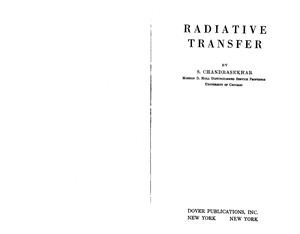Oxford, Clarendon Press, 1950, 405 pp.
The problem of specifying the radiation field in an atmosphere which scatters light in accordance with well-defined physical laws originated in Lord Rayleigh's investigations in 1871 on the illumination and polarization of the sunlit sky. But the fundamental equations goveing Rayleigh's particular problem had to wait seventy-five years for their formulation and solution. However, the subject was given a fresh start under more tractable conditions, when Arthur Schuster formulated in 1905 a problem in Radiative Transfer in an attempt to explain the appearance of absorption and emission lines in stellar spectra, and Karl Schwarzsehikl introduced in .1906 the concept of radiative equilibrium in stellar atmospheres. Since that time the subject of Radiative Transfer has been investigated principally by astrophysicists, though in recent years the subject has attracted the attention of physicists also, since essentially the same problems arise in the theory of the diffusion of neutrons.
Contents
The equation of transfer
Quadrature formulae
Isotropic scattering
Principles of invariance
The H-functions
Problems with general laws of scattering
Principles of invariance (continued)
The X- and the Y-functions
Diffuse reflection and transmission
Rayleigh scattering and scattering by planetary atmospheres
The radiative equilibrium of a stellar atmosphere
Further astrophysical problems
Miscellaneous problems
Appendices
Subject index
Index of definitions
The problem of specifying the radiation field in an atmosphere which scatters light in accordance with well-defined physical laws originated in Lord Rayleigh's investigations in 1871 on the illumination and polarization of the sunlit sky. But the fundamental equations goveing Rayleigh's particular problem had to wait seventy-five years for their formulation and solution. However, the subject was given a fresh start under more tractable conditions, when Arthur Schuster formulated in 1905 a problem in Radiative Transfer in an attempt to explain the appearance of absorption and emission lines in stellar spectra, and Karl Schwarzsehikl introduced in .1906 the concept of radiative equilibrium in stellar atmospheres. Since that time the subject of Radiative Transfer has been investigated principally by astrophysicists, though in recent years the subject has attracted the attention of physicists also, since essentially the same problems arise in the theory of the diffusion of neutrons.
Contents
The equation of transfer
Quadrature formulae
Isotropic scattering
Principles of invariance
The H-functions
Problems with general laws of scattering
Principles of invariance (continued)
The X- and the Y-functions
Diffuse reflection and transmission
Rayleigh scattering and scattering by planetary atmospheres
The radiative equilibrium of a stellar atmosphere
Further astrophysical problems
Miscellaneous problems
Appendices
Subject index
Index of definitions

